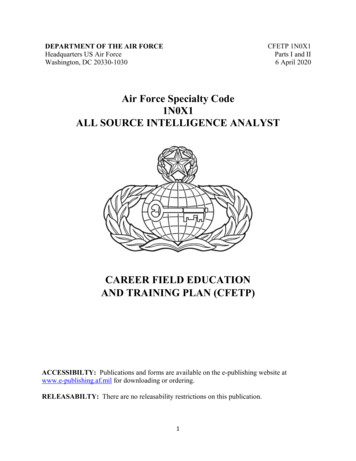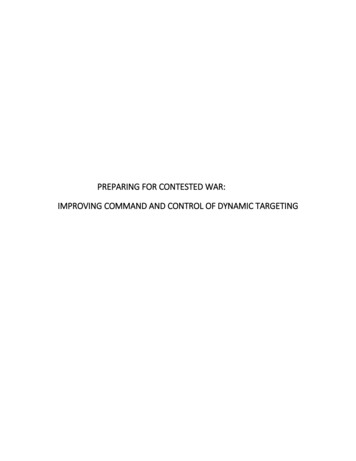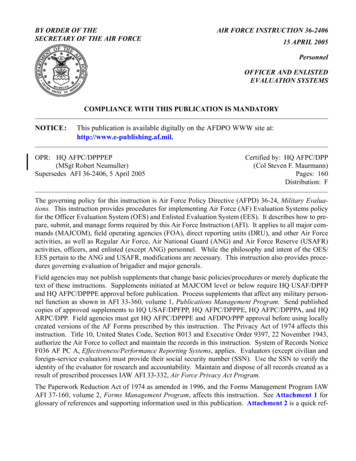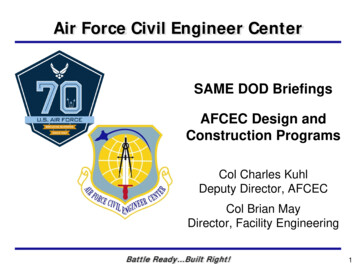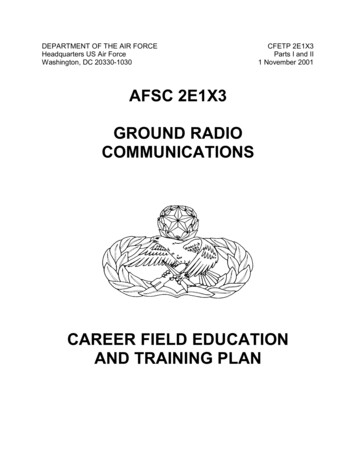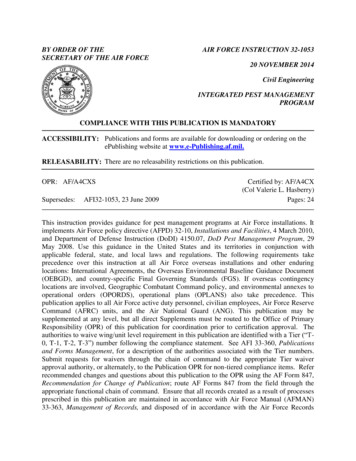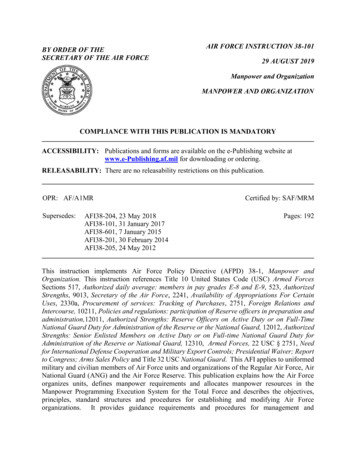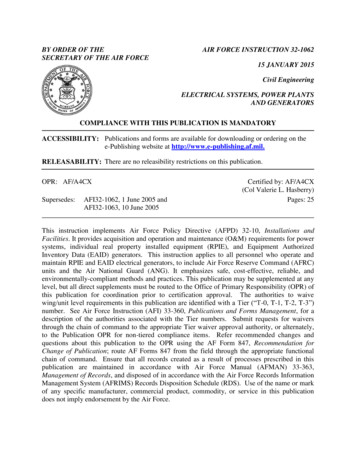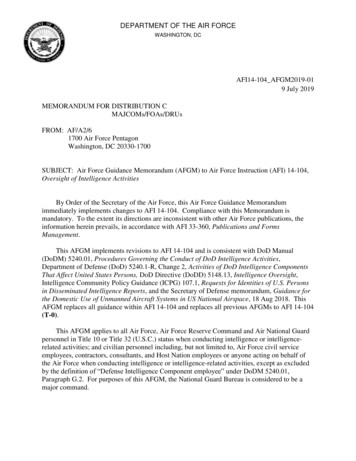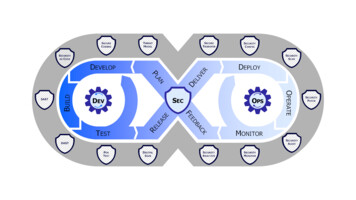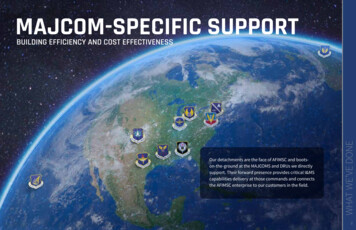
Transcription
MAJCOM-SPECIFIC SUPPORTOur detachments are the face of AFIMSC and bootson-the-ground at the MAJCOMS and DRUs we directlysupport. Their forward presence provides critical I&MScapabilities delivery at those commands and connectsthe AFIMSC enterprise to our customers in the field.1WHAT WE’VE DONEBUILDING EFFICIENCY AND COST EFFECTIVENESS23
Detachment 1Detachment 2supportingAir Force SpaceCommandHighlightsHighlightsAFIMSC Detachment 1 plays a crucial role in seeking the most effective and efficient means in which to supportunique and diverse space missions. “Our defense efforts must be agile and adaptable to assess threat conditionsin order to anticipate, deter, detect and defeat those threats that may influence a secure operating environment,”said Gen. John E. Hyten, U.S. Strategic Command commander and former AFSPC commander. The AFSPC missioncontinues to grow as emerging weapons systems come on board and mission partners attain operational status.Michael Reiber of Detachment 1 monitors six major operating bases and 63 geographically separated unitsand electronic security systems. He works directly with both the Air Force Life Cycle Management Center andAir Force Security Forces Center to develop and execute electronic security systems installation and upgraderequirements across AFSPC. Reiber works with wing personnel to educate end users on sensor performance andadvocate for system support, supporting requirements and contract language development, technical evaluationsof proposals, design reviews and installations, and test and turnover. This past year, the team supported 13electronic security projects in various levels of completion, totaling almost 56 million. Understanding equipmentcapabilities and limits and local environments from the Arctic to the tropics, mission systems and threats provideinvaluable insight to electronic security system requirements development.AFIMSC Detachment 2’s many missions in support of Pacific Air Forces include facilities planning andprogramming for bilateral military exercises at Royal Australian Air Force Bases Darwin and Tindal. Financial management provided weekly monitoring of AFSPC FY17 wing execution rates to achieve a100-percent obligation rate on Sept. 30, 2017. AFSPC installations executed more than 345 million of Air ForceCivil Engineer Center and AFIMSC funding in FY17.Emergency Services supported natural disaster recovery efforts at Peterson AFB, Colorado, Vandenberg AFB,California, and Patrick AFB, Florida. Detachment 1 staff worked diligently with wings and AFIMSC by executing 31 million in FY17 for restoration and recovery efforts resulting from hail, fires, hurricanes and windstorms.Supported Emergency Management activities at seven AFSPC Installations, two launch ranges and nine GSUsproviding space and cyberspace capabilities around the world. EM staff provided constant engagement onoperational and policy issues, collaborating with flights, AFCEC and AFIMSC staff ensuring preparedness formore than 30,000 AFSPC members.Liaised with AFSPC and Vandenberg AFB for short- and long-term communications infrastructure repair andreplacement by coordinating support to affect immediate repairs following a devastating launch range fire.This enabled resumption of space launch activities within 45 days of fire.Completed Cape Canaveral and NASA install supporting the enhanced expendable launch vehicle programto develop unique standards and meet assured access to space goals.Provided Explosive Ordnance Disposal Staff Assistance Visits to the 45th, 30th and 21st Space Wings’ EODflights with focus on equipment accountability and maintenance standards.Served as Civil Engineer lead for 15 AFSPC strategic basing initiatives; garnered Secretary of the Air Forceapproval for three actions.Developed eight Fire Emergency Services vehicle variance justifications for five flights and coordinatedapproval with the 441st Vehicle Support Chain Operations Squadron at Joint Base Langley-Eustis, Virginia,and AFCEC during the enterprise-wide vehicle validation and realignment process.Successfully consolidated, centralized and standardized seven AFSPC GeoBase web servers that support35 sites.A particular area of emphasis was the integration of fuel facilities using a U.S. standard design for cut-andcover bulk fuel storage at both installations, based on similar U.S. facilities in PACAF. Australian acceptanceof the cut-and-cover design presented a challenge as it had never been attempted before in that nation andthere were no Australian Defence or commercial storage facilities available to visit. To address the challenge,Detachment 2 team members escorted a team of RAAF personnel on a comprehensive tour of the fuel tankstorage and distribution systems at Misawa Air Base, Japan. RAAF personnel were very impressed with thesystem reliability, redundancy, ease of maintenance and sustainability. After the visit, our Australian partnersagreed to move forward with the cut-and-cover design.Other Accomplishments Processed 14,000 Individual Antiterrorism Plans mandated by the commander of the Pacific Air ForcesCommand for all foreign travel, with 136 of those requiring staffing for flag officer approval.Framed critical force protection plans during 15 theater security cooperation and building partnershipcapacity events.Synced and coordinated a 10-year outdated memorandum of agreement with the Royal Thai Navy andJoint U.S. Military Advisory Group to secure PACAF assets.Organized 36 PACAF threat working groups and crafted mitigation plans for nine installations, executingthe PACAF and U.S. Pacific Command mission.Championed Cope North Security Forces field training exercise for Australia, Japan and DoD, whichhoned command and control tactics, techniques and procedures for the largest security forces combinedand joint event in theater.Led security forces exchange with seven nations, which bolstered security ties. The PACAF deputycommander lauded the program as being key to growing partner countries.Established the standard for resilient fuel systems in PACAF area of responsibility and developed 35.2million infrastructure repair plans to ensure sustainability of critical fuel nodes.Directed 49 U.S. Secret Service and Very Important Persons Protection Support taskings involving98 personnel and 27,000 man-hours to safeguard the president, first family, vice president and43 Pacific leaders.Managed military construction and operations and maintenance project planning and programming tooverhaul 1,789 government-owned military family housing units across Japan, Korea and Guam, plus 26 million in infrastructure upgrades to improve quality of life for thousands of Airmen and their familymembers, while also contributing to military readiness.Planned and coordinated a 13,557-room dorm update to support the PACAF Dorm Master Plan. TheDetachment 2 team gathered the most up-to-date building conditions to generate a comprehensivesustainment and investment plan for the Air Force.WHAT WE’VE DONEOther accomplishments3supportingPacific Air Forces4
Detachment 3Detachment 4HighlightsHighlightsThe Detachment 3 innovation team and Air Force Special Operations Command it supports recognized theneed to improve. The detachment team developed a major command supplement to Air Force Manual 321084, Facility Requirements and e-Tool, to establish accurate and scalable facility requirements for SpecialOperations Forces’ unique weapon systems.The AFSOC supplement and Toolkit to the manual offers simple selection inputs, resulting in near-instantvalidated facility requirements, notional manpower and rough order of magnitude costs. Real-world use of thesupplement and e-tool saved Airmen time and money by accurately estimating costs for relocation of the 352ndSpecial Operations Wing from Royal Air Force Mildenhall, England, to Spangdahlem AB, Germany; bed-down ofCV-22s at Yokota AB, Japan; and facility upgrades for the 353rd Special Operations Group at Kadena AB, Japan.Other Accomplishments Supported Headquarters U.S. Air Forces in Europe-led Site Activation Task Force to relocate 352nd SOWfrom RAF Mildenhall to Spangdahlem AB.Completed AC-130J recapitalization intra-MAJCOM study to support 5.5 billion program.Detachment 3 security forces developed a multi-step plan to close shortfalls in advanced designatedmarksman training UTC requirements by gaining Air Force Security Forces Center approval to teach thecourse at home station instead of the regional training center.Developed an interim facility solution for the C-146A Weapon System Trainer at Hurlburt Field, Florida,an AFSOC commander’s priority initiative that will allow AFSOC to discontinue a 2 million-per-yearcommercial training program.Financial managers worked with the AFIMSC Resources Directorate team and AFSOC installationcomptrollers to execute financial requirements throughout FY17 and garnered 7.45 million in additionalfunding for small sustainment, resiliency program, overseas contingency operations and Commander inChief’s Installation Excellence Award, and 8.8 million for facility projects. During FY17 end-of-year, AFSOCreceived 3.5 million for wing commanders’ top priorities (Hurlburt Field, 1.4 million, Cannon AFB, NewMexico, 1.6 million, and 66th Air Operations Squadron at Pope Army Airfield, North Carolina, 477,100).Supported AFSOC A4 Summit held at Hurlburt Field and attended by AFSOC mission support groupcommanders, squadron commanders and chiefs for civil engineers, logistics, security forces andmaintenance personnel.Capt. Jason Sawyers excelled as the continuous process improvement learning and development team leadand chartered to institutionalize CPI within AFIMSC by training CPI practitioners. He established practicalproblem-solving method training for AFIMSC newcomers and developed a CPI training plan for AFIMSC.Supported 27th SOW Area Development Plan to address facility and infrastructure deficiencies byconducting interviews and data collection with 27th SOW personnel and reviewing contractor submittals.supportingU. S. Air ForcesIn EuropeDetachment 4 managed 497 million across U.S. Air Forces in Europe-Air Forces Africa in FY17, spanning 104countries and 71 geographically separated units across Europe and Africa. Through deliberate planning anda phased approach to managing information technology services, the communications division oversaw acombined 21 billion in IT services and infrastructure across the USAFE theater.Detachment 4’s civil engineers oversaw an 18 billion physical plant in FY17 across the command. The CEdivision directs long-range planning and execution of more than 1 billion in basing actions in 56 countriessupporting the North Atlantic Treaty Organization and U.S. objectives. The CE team also created a trackingmechanism for all explosive ordnance device personnel in USAFE-AFAFRICA, sorted by specialized trainingcourses. This enables Detachment 4’s subject matter experts to have immediate visibility on which personnelrequire training, significantly reducing the time required to match personnel against training slots. Thistool has been adopted and modified by the Expeditionary Support Directorate at HQ AFIMSC to track EODpersonnel training enterprise-wide.Other Accomplishments 5 2.4 million in wing commander’s number one unfunded requirements. 2.6 million got Aviano Air Base, Italy, land mobile radio replacement and upgrades, resolving atwo-year-old issue of aged equipment. 2 million for an Incirlik AB, Turkey, lease shortfall. 1.9 million for Air Force Civil Engineer Center combined tasking order project at Ramstein AB, Germany,Moron Air Base, Spain, Lajes Field, Portugal, and Royal Air Force Lakenheath, England.Executed 3.8 million in European Infrastructure Consolidation projects and 54 million in EuropeanReassurance Initiative projects.Funded 66 million in overseas contingency operations requirements throughout FY17.Executed 538,000 for USAFE’s Space and Naval Warfare Systems Command contract for electronicsecurity systems.Led USAFE cyber engineering and installation project management for 54 planners, which involvedengineering solutions and advocating funding for 63,000 personnel.Managed execution of 56 cyber projects; mapped 9.9 million in IT requirements for support of the 112million F-35A bed-down program to ready USAFE for its first squadron of fifth generation aircraft.Managed USAFE FY19 existing mission MILCON program composed of 47 projects and 1 billion inrequirements across five countries, enabling three MILCON projects postured for funding in Future YearDefense Program.Oversaw a 114 million FSRM program, validating and advocating for 485 projects across 11 installations.Formulated a 1.2 million MAJCOM blanket purchase agreement contract that streamlined safety gearrequirements for 1,000 firefighters and 13 bases across USAFE, saving 290,000 in FY17.Acquired 11 new EOD response vehicles providing dual response capabilities, effectively allowing oneon-base team and one off-base team to respond at the same time.WHAT WE’VE DONEsupportingAir Force SpecialOperations Command6
Detachment 5Detachment 6HighlightsHighlightsAFIMSC Detachment 5 delivers agile installation and mission support across the Air Force District of Washingtonenterprise and is the designated single Air Force voice for planning and implementing Air Force and jointsolutions concerning the National Capital Region. Engineers plan and prepare for significant management inthe NCR, supporting senior leader and continuity of government. Detachment 5 engineers deliver airfield andbase infrastructure support, response and staging of forces at Joint Base Andrews, Maryland, aerospace control,and defense over the NCR and president of the United States support activity missions, which ensure the safetyand protection of the president and other senior leaders. The detachment orchestrated future recapitalizationof Joint Base Andrews’ critical airfield infrastructure and led a 300 million military construction planning andprogramming effort to support bed-down of the Presidential Aircraft Recapitalization Program. Detachment 5safeguarded a 13 million, 21-point firing range MILCON project, securing a future training facility for DoD andinteragency personnel across the NCR. Detachment 5 also teamed up with the Air Force Financial ManagementCenter of Expertise to steer an economic analysis effort and determine the most systematic solution to design anew 13 million child development center construction project.Detachment 6 provides I&MS support to the Air Force Materiel Command and its nine host bases.Other Accomplishments 7Directed MILCON planning and programming strategy in support of the more than 300 millionPresidential Aircraft Recapitalization Program.Executed a wetlands and stream mitigation bank, the first of its kind in the Air Force, which establishedstandard processes to offset wetlands destruction on Air Force bases.Obtained Secretary of the Air Force Installations, Environment and Energy approval for a four-phase, 129 million taxiway reconstruction at Joint Base Andrews.Synchronized major efforts to enable funding for a 66 million east runway and airfield drainage projectfor the 113th Wing and District of Columbia Air National Guard and supported multiple constructionprojects including a 50 million communications center consolidation, a 13 million 21-point enclosedfiring range and a 13 million child development center.Advocated for repair of an electrical substation reprogramming effort, which safeguarded a 16.2 millionoperations and maintenance funded project and achieved re-approval by SAF Installations, Environmentand Energy.Supported one of the largest air shows in the Air Force at Joint Base Andrews, which showcases the AirForce to thousands of people in the National Capital Region.Delivered significant support to the 11th Wing during the financial year-end closeout. Detachment 5’sbudget analyst was personally responsible for AFDW achieving a more than 99-percent obligation rate.Assisted AFDW in assuming control and responsibility for the operations and maintenance of the AirForce Memorial from Air Force Association, which guarantees this national monument in the NCR will besustained for generations to come.supportingAir Force MaterielCommandIn FY17, Detachment 6 achieved a significant accomplishment by rectifying a major programmatic fundingshortfall of 59 million per year across the Future Year Defense Program, totaling 300 million. This benchmarkevent had not been accomplished for the command since September 2011.Improving communications and technology were critical focus areas for Detachment 6 in FY17. The teameffectively managed the AFMC Defense Information Systems Agency’s 67 million information technologyportfolio, directly supporting the warfighter. As part of their support, the detachment garnered 9.2 millionin funding for 11 critical cyber infrastructure projects and funded a 1.1 million Operating Location-Plant 42,California, enterprise land mobile radio system at Edwards AFB, California. The network expansion linked 2,200research, test, development and evaluation LMR system users. In addition, the team spearheaded a 3 millioneffort at a joint fire station at Eglin AFB, Florida, which decreased airfield response to under two minutes for22,500 flights per year.Other Accomplishments Levied congressional Omnibus reprogramming funds of 2.6 million to modernize and double capacityof a 30-mile, point-to-point digital microwave, line-of-sight, radio system at Edwards AFB, California, tomodernize critical communications base infrastructure.Funded fiber optic cabling modernization project, allowing critical communications base infrastructureto support the expansion of Air Force Research Laboratory, National Museum of the Air Force and MidwestFederal Emergency Management Agency Regional Disaster Recovery Area missions.Authored Robins AFB, Georgia, security system project description in order to replace an uncertified securitysystem on the certified list, making the system eligible for centrally funded fix site sustainment, saving theinstallation from having to pay the maintenance costs out of its own budget.Tinker AFB, Oklahoma, awarded a 243 million energy savings performance contract which placed thefederal government over the top of the President’s Performance Contracting Challenge goal. Tinker’s effortwas further recognized with a White House Award.AFIMSC Detachment 6 manages contracts supporting GeoBase programs on 50 installations in AFMC, ACC,AFSOC, AETC, AFSPC, Air Force Central Command and Air Forces Southern, including a 4.2 million mappingand geographic information systems support contract. Maintained network certification and providedtechnical support to AFMC installation and MAJCOM online mapping systems serving more than 20,000users.Conducted high level, technical review of over 30 National Environmental Policy Act-related documents forAFMC senior command civil engineer approval. Actions included test support for facility construction for theVerizon Wireless Tower at Arnold AFB, Tennessee, a solar array enhanced use lease, a National Aeronauticsand Space Administration proposal on Rogers Dry Lake bed and a California Department of TransportationKramer Junction Expressway at Edwards AFB.WHAT WE’VE DONEsupportingAir Force Districtof Washington8
Detachment 7Detachment 8HighlightsHighlightsDetachment 7, in support of Air Education and Training Command, facilitated 676 million in FY17 installationand mission support obligations. This was the Air Force’s largest program. The detachment championedAETC installation active construction execution programs in alignment with both AFIMSC and AETC goals andsupported 117 facility sustainment, restoration and modernization projects valued at 169 million and 41military construction projects valued at 726 million.Detachment 8 supported Headquarters Air Combat Command across the spectrum of installation and missionsupport functions. The Basing and Bed-down Branch provided facility, environmental and logistics expertiseto HQ ACC’s Strategic Basing Division, supporting 33 basing actions by tracking, reviewing and validatingmore than 130 facility sustainment, restoration and modernization, military construction, UMMC and logisticsrequirements valued at 1.7 billion. They guided ACC Air and Space Operations’ crafting of Program ObjectiveMemorandum inputs for new Remotely Piloted Aircraft operations group and wing, totaling over 350 millionin military construction for the Future Year Defense Program to support one of ACC’s top mission priorities.Other Accomplishments Provided infrastructure guidance and facilitated repairs and enhancements of Battlefield Airmen campusfacilities at Joint Base San Antonio, Texas. Assisted execution of 20 million to meet the Chief of Staff ofthe Air Force priority item and coordinated 4.9 million in equipment and 8 million in operations andmaintenance requirements, including 3.1 million to repair the aquatics training facility.Supported advancement of AETC’s capacity to train Airmen by planning, programming and advocating for 400 million in basic military training recapitalization and 22 million in repairs to student housing facilities,including medical education and training campus dorms at Joint Base San Antonio.Supported relocation of F-16 Formal Training Unit from Luke AFB, Arizona, to Holloman AFB, New Mexico.Led development, advocacy and execution of 14 million in facility renovations to bed-down 45x F-16s andenable the stand-up of a new Block 40 FTU flying unit to complement the two F-16 FTU fighter squadronspreviously moved to Holloman.Provided civil engineer program management for other strategic basing efforts, including various FTUs(F-35A, F-16, KC-46A, MQ-9 and Combat Rescue Helicopter) and T-X basing plans in actions totaling more than 810 million in new infrastructure. Supported the preparations to transfer Holloman AFB from Air CombatCommand to AETC in FY19.supportingAir Combat CommandThe Expeditionary Support Division developed the Fire and Emergency Services Budget Management Tool incoordination with the Air Force Civil Engineer Center and HQ AFIMSC. This spreadsheet-based tool providesa straightforward method for fire emergency services flight chiefs to capture all funding requirementsneeded to operate a fire department. It was presented to the AF Fire and Emergency Services working groupand adopted for use across the enterprise. The division also created the emergency response capabilitydashboard for ACC installations, allowing leadership to identify gaps in emergency response capabilities. TheERC tool is an important step to the eventual “Health of the Installation” or “Mission Assurance” IntegratedRisk Management Program.Other Accomplishments 9Resource Management Division facilitated 14 ACC wing commanders in executing their top prioritiesat end-of-year FY17, totaling over 8.9 million.Allocated sufficient manpower from existing mission set to fulfill critical National EnvironmentalPolicy Act liaison role to steer the NEPA process to ensure critical milestones are being met and themission is progressing.— Combat Air Force Adversary Air: Coordinated scoping of environmental impact analysis processleading to award of an environmental analysis contract for six NEPA-ready sites and hosting ofinitial site visit to meet the performance start date of May 19.— MQ9 - BASE X EIAP: Ensured all ground work was done to award the environmental assessmentcontract ahead of schedule to meet a Nov. 30 need date.— MQ9 - BASE Y EIAP: Facilitated AFCEC to stabilize the description of proposed action andalternatives and EIAP contract documents.Provided vital aircraft arresting system subject matter expert support to ACC bases and othermajor commands.— Provided design work on projects to install BAK-14 cable retraction systems on Nellis AFB,Nevada. Runway approved and continued technical guidance is currently being provided to the820th RED HORSE Squadron.— Provided comments to Joint Strike Fighter program office with regard to Lockheed draft reporton F-35A compatibility testing with the Air Force’s standard arresting system (BAK-12/MAAS) andparticipated in key discussions.WHAT WE’VE DONEsupportingAir Education& Training Command10
Detachment 10supportingAir Mobility CommandsupportingAir Force GlobalStrike CommandHighlightsHighlightsDetachment 9 is AFIMSC’s first stop for Air Mobility Command Mission Support Groups. They work closelywith installations to provide guidance for developing facility sustainment, restoration and modernizationand military construction programs to ensure they are execution-ready. As a result, civil engineer squadronsawarded 101 FSRM projects in FY17 valued at 55.7 million, capitalizing on AMC year-end dollars in additionalto AFCEC’s combined tasking order project funding. Additionally, the emergency services team partnered withAFCEC and various installations to implement an Air Force Firefighter Personal Protective Equipment contract.After five years of working the details, the Air Force Installation Contracting Agency awarded this strategicPPE contract. In support of basing and bed-down, the team collaborated with users and headquarters staff toprepare McConnell AFB, Kansas, Joint Base McGuire-Dix-Lakehurst, New Jersey, and Travis AFB, California, toreceive KC-46A aircraft while simultaneously posturing Fairchild AFB, Washington, and MacDill AFB, Florida, toreceive additional KC-135s.At the request of Air Force Global Strike Command deputy commander, Detachment 10 coordinated withinstallations and multiple AFIMSC offices to create a comprehensive “State of The AFGSC Dorms” briefing,which validated dorm quality and quantity shortfalls at several AFGSC bases. Detachment 10 then supportedthe deputy commander’s and CCC’s engagement with Headquarters Air Force and Secretary of the Air Forceleadership as they pressed for a revised AF dorm policy and funding strategy. This effort resulted in a newHeadquarters Air Force Logistics, Engineering and Environment “Installation of the Future” initiative thatreviewed several AF dorm policies for potential adjustment, which was reviewed and endorsed by the ChiefMaster Sergeant of the Air Force and major command CCCs.One example of the team’s DNA was exhibited by Tech. Sgt. Christopher Clohessy. He quickly mobilized toTampa, Florida, and Charleston, South Carolina, to provide financial services expertise for Hurricane Irma postevacuation efforts. From Sept. 14-30, he standardized evacuation payment procedures, facilitated paying morethan 6,500 vouchers valued at 11 million, and briefed 1,000 members and dependents at two bases providingcrucial claims guidance to affected families. Clohessy exhibited the highest standards of professionalism anddedication a model AFIMSC Wingman.Detachment 10 provided the AFGSC deputy commander a comprehensive dashboard that gives an overviewof the status of all security forces small arms ranges and military working dog kennels for the eight AFGSCinstallations. As a result, the deputy commander asked the AFIMSC enterprise for an in-person subject matterexpert site visit to every AFGSC kennel and range. Detachment 10 partnered with the AFIMSC InstallationSupport Directorate, Air Force Civil Engineer Center and Air Force Security Forces Center to arrange visits. Onvery short notice, the SME teams performed deep-dive, on-site visits at all eight installations and prepareda tailored report for each base with dozens of recommendations installation leadership could purse to startimproving the quality and safety of their ranges and kennels. Using the AFGSC data, the SME team alsobrought back several action items for the AFIMSC enterprise to work on behalf of all AF installations.Other AccomplishmentsOther Accomplishments 11Led 100 million end-of-year closeout for AMC bases; balanced efforts across 12 units and stakeholders—significant facility sustainment, restoration and modernization investments in strategic capability.Planned, programmed and synchronized I&MS for AMC’s acquisition-related new mission bed-down programs.— Teamed with multiple agencies working the MILCON projects, environmental impact statementand wetland bank mitigation in support of the Presidential Aircraft Recapitalization Program.Planned, programmed and synchronized I&MS for AMC’s existing mission basing actions— Shepherded C-17 Weapons Instructor Course bed-down emergent requirement.— Enabled 60th Aeromedical Evacuation Squadron activation at Travis AFB, California.Assessed AMC’s 63 Entry Control Points against 25 items of interest and yielded quantifiable data forestablishing projects on the most degraded elements of AMC ECPs.Supported Integrated Data Call requirements.— Analyzed FY20 installation MILCON submittals, totaling 50 projects valued at 1.5 billion.— Coordinated development of AMC’s integrated priority list and 633 requirements totaling 978million; assisted civil engineering squadrons by ensuring projects were programmed correctly andscored appropriately.Fashioned DoD Commercial Gateway Force Protection memorandums of understanding with bothSeattle-Tacoma International Airport and Baltimore Washington International Airport to enhance forceprotection through collaboration with civilian agencies.Provided operational test and evaluation emergency management and chemical, biological, radiologicaland nuclear support to 120,000 AMC and 32,000 Air Force District of Washington members — Mobility AirForces and District of Washington postured for mission continuity. Advocated fiscal needs for the eight AFGSC installations and secured 315 million in FY17 funding,including 97 million for 133 construction task order projects, of which 11 were pulled forwardfrom FY18.Led over 1 billion in basing and bed-down efforts
The Detachment 3 innovation team and Air Force Special Operations Command it supports recognized the need to improve. The detachment team developed a major command supplement to Air Force Manual 32-1084, Facility Requirements and e-Tool, to establish accurate and scalable facility requirements for Special Operations Forces' unique weapon systems.
